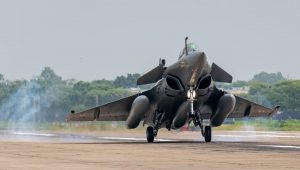The first Rafales have finally arrived in India, after an extraordinarily long and bumpy process. Dassault handed over three aircraft to India in November, although these remained in France for training purposes. Five aircraft left France earlier this week, and arrived in India after a brief stop in the UAE. The first five aircraft include three single seat and two twin seat fighters.
India’s effort to acquire Dassault Rafale fighters from France is an epic worthy of Turold or Valmiki. Originally, India sought a co-productive arrangement with France that would have included technology transfer and a total of at least 126 fighters. This would have modernized both the existing stocks of the Indian Air Force and the technical capabilities of Hindustan Aeronautics Limited, which would have assembled over a hundred of the aircraft. The big deal was replaced by a small deal, in which France would supply 36 aircraft “off the shelf” without any technology transfer. Even that deal ran into trouble, with India hedging and delaying before finally giving the formal go ahead in the autumn of 2016.
These difficulties proved deeply frustrating to France, at one point threatening to put the entire defense relationship at risk. They also highlighted dysfunction within India’s defense establishment, which over the past decade has seemed incapable of settling on an answer to how to manage its inevitable fighter shortage. The Rafales will serve to patch existing gaps in the Indian Air Force’s fighter fleet that have come about because of retirements to older MiG-21s and MiG-27s. These gaps were foreseen for a long time, but India has struggled to make effective decisions on its fighter fleet, continuing to pursue the HAL Tejas (regarded as insufficient by most aviation analysts) and breaking an agreement with Russia to co-develop the Su-57 Felon stealth fighter. Tensions with both Pakistan and China (the former of which resulted in the loss of an Indian fighter jet during a cross-border strike) have brought the problem into stark relief.
France is still open to sending additional Rafales to India. Tensions with China may make New Delhi more flexible about acquiring more aircraft from a politically uncomplicated partner such as France. The United States has also expressed interest and willingness to export modern fighters to India, including possibly the F-15EX. But all of this depends upon making the acquisition process in India more accessible and coherent, and more in line with India’s long-term strategic goals.
































